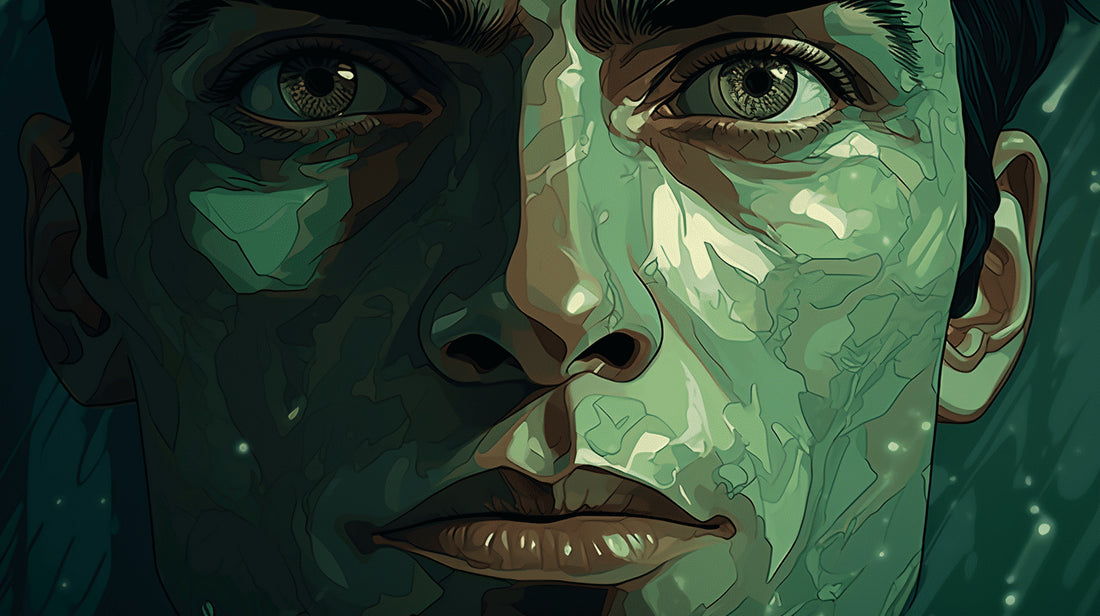Every gentleman aims for a smooth and refreshing shave, but one common adversary often stands in the way - shaving rash. More than just a minor inconvenience, this skin irritation can transform the daily shaving ritual into an uncomfortable encounter. Add to that the redness, the itch, and remember those unsightly bumps. Scary, isn't it? But there are ways to combat this common problem! And it all begins with understanding what causes shaving rash and investing in good quality aftershave balms. These products can be a shaving game-changer, providing soothing relief and improving your skin's health over time. So join us as we commence this journey into the solutions to shaving rash, peeling the layers off this common problem while exposing the best aftershave balms to turn to in 2024. Remember, your shaving regime need not be a battleground with the right tools and approach.
Understanding Shaving Rash
Do you often find your skin inflamed and irritated after shaving? If so, chances are, you've been dealing with a case of shaving rash, also known as pseudofolliculitis barbae. This common skin condition may trigger discomfort, but rest assured, it is usually straightforward to handle and prevent with a bit of knowledge and caution. This section will guide you through the common causes and symptoms of shaving rash, helping you steer clear of this pesky skin problem.
Common Causes of Shaving Rash
Before you can treat or prevent shaving rash, it's crucial to understand what causes it. More often than not, shaving rash springs up due to:
- Incorrect Shaving Techniques: Using a blunt, old, or dirty razor can greatly irritate your skin. Additionally, dry shaving or shaving against the direction of hair growth can cause friction and lead to shaving rash.
- Sensitive Skin: Some people have skin that's particularly prone to irritation. For these individuals, even the slightest friction or contact with harsh substances can provoke a rash.
- Allergic Reactions: Did you know your shaving cream or lotion could also be the culprit? If they contain ingredients that your skin disagrees with, they might be causing an allergic reaction that presents as a shaving rash.
Always remember, prevention is better than cure. Using the right shaving tools and techniques, coupled with suitable skincare products, can largely help avoid the occurrence of a shaving rash.
Symptoms of Shaving Rash
Here's a pro tip for skincare enthusiasts; watch out for early signs of shaving rash. This way, you can nip the problem in the bud and prevent it from escalating. Typical symptoms to look out for include:
- Redness: This is generally the first and most prevalent sign. If the areas you've shaved start turning abnormally red, it could very well indicate the onset of shaving rash.
- Itching: Itching is another common symptom. This isn't restricted to just when you're shaving but can continue even after you're done.
- Bumps: Another clear indicator of shaving rash is the appearance of tiny bumps on the skin soon after shaving.
Always listen to what your skin has to tell you. By paying attention to these symptoms, you can step in early to soothe your skin and prevent further irritation.
Shaving rash, albeit common, doesn't have to be a perpetual worry. Armed with this knowledge about its causes and symptoms, you're well on your way to effectively managing and preventing this skin condition. In the end, remember, it's all about learning to care for your skin in the best way possible!
The Role of Aftershave Balms in Combating Shaving Rash
For many, the routine of shaving is not just about maintaining a smooth image, but also a 'dance' with persistent irritation commonly known as shaving rash. Fortunately, more people are discovering that aftershave balms are an excellent antidote to this common adversity. Yet, what exactly is the function of this skin savior and how does it banish shaving rashes? Let's delve into the role of aftershave balms and explore some vital ingredients to look for when buying one.
How Aftershave Balms Protect the Skin
An integral component of a fine shave, aftershave balms maintain healthy skin by tackling the harsh implications of shaving. They soothe and rejuvenate the skin, preventing it from drying out and mitigating inflammation. The immediate relief these balms provide after a shave is from their hydrating nature. Here's a brief synopsis of how these balms rise to the occasion:
- Dealing with irritation: Aftershave balms do an excellent job of calming the skin. They mitigate the prickling sensation that springs forth after shaving.
- Moisturizing the skin: Shaving can leave your skin parched. Not to worry, these balms restore moisture to your skin, guarding it against dryness and peeling.
- Fighting inflammation: Post-shave, your skin might be inflamed due to the abrasive action of the razor. Aftershave balms are equipped with elements that fight this inflammation and promote healing.
Ingredients to Look for in Aftershave Balms
Like superheroes with their signature weapons, a good aftershave balm has defining ingredients that set it apart. Knowing these components can help you select the most effective balm for your skin. Some key ingredients to hunt for are:
- Aloe Vera: Famed for its soothing properties, Aloe Vera helps to alleviate irritation while promoting skin healing.
- Vitamin E: It's an antioxidant powerhouse with the ability to heal wounds and reduce skin inflammation.
- Shea Butter: This natural ingredient is a fantastic skin moisturizer, providing deep hydration for your skin after a shave.
- Witch Hazel: It acts as an astringent, shrinking pores and reducing inflammation, making it perfect for combatting shaving rash.
Ultimately, remember that personal skincare routines are indeed personal. Choosing an aftershave balm should come down to your skin type, whether you have sensitive, dry, or oily skin, as well as your personal couplings with these ingredients. However, with knowledge on the importance of aftershave balms and insight into their power ingredients, you're well-equipped to make an informed choice, ensuring the balm you choose does exactly what it’s supposed to do: protect, soothe, and enrich your skin, kissing shaving rash goodbye.
Best Aftershave Balms for Shaving Rash in 2024
Shaving rash is one of those niggling issues that disrupt many a gentleman's grooming routine. You've just finished a meticulously executed shave when suddenly your skin erupts in a sea of angry red bumps. That stinging sensation swiftly turns your morning of masculine self-care into a day of discomfort. But fear not, there's no need to lose your cool or your clean-cut looks, as the world of grooming has many solutions to offer. One such solace comes in the form of aftershave balms, specifically formulated to soothe shaving rash.
Targeting the core issue, these balms come packed with natural extracts, soothing oils, and skin-nourishing ingredients that provide instant relief from the evil ailment. But with countless brands and wide range of options available on the market, how do you choose the one that fits your skin the best? That’s where we come in. Below is the list of the top aftershave balms that promise to alleviate your shaving rash in 2024.
- The Cooling Calendula Balm: This gem's magic lies in its powerful organic ingredients - calendula, chamomile, and shea butter. With their anti-inflammatory and skin-soothing properties, they provide immediate relief from razor burn and soften roughened skin.
- The Nourishing Aloe Balm: Designed for total hydration, this balm combines aloe with lavender and chamomile. This ultimate trio acts as a skin tonic and safeguards our skin against damage.
- The Soothing Jojoba Balm: This one traps moisture in your skin while forming a protective barrier against the outside elements. The primary ingredient, Jojoba oil, contains anti-inflammatory and antibacterial properties, banning shaving rashes goodbye.
- The Balancing Tea Tree Balm: Infused with Tea Tree oil known for its anti-fungal and anti-bacterial traits, this balm is a brilliant option for effectively treating shaving bumps.
"A well-aimed arrow doesn't always hit the mark but a well-chosen aftershave balm does."
By considering your skin type and the severity of your shaving rash, you can arm yourself with the right aftershave balm to conquer distressing skin issues. Remember, self-care isn't a luxury; it's a necessity. So embrace the world of skincare and incorporate the healing touch of a quality aftershave balm in your routine today.
How to Effectively Use Aftershave Balms
Pre-Shave Preparations
An often overlooked but critical step in the shaving process is the pre-shave preparation. Many men hurry to get the razor on their face, forgetting that the secret to a pleasurable and comfortable shave often lies in pre-shave routine. One essential pre-shave step is to open your pores, which effectively softens your facial hair. You can achieve this by either taking a hot shower or by placing a warm towel over your face for a couple of minutes.
Bullet point list for Pre-Shave Preparations:
- Take a hot shower or apply a warm towel to the face: This enables the pore opening, affording an easier and smoother shave.
- Exfoliate: A good exfoliant can make a significant difference in your shave. It refreshes and rejuvenates your skin, preparing it for a smoother shave.
- Apply a pre-shave oil: This step further softens your beard and moisturizes your skin, providing an additional layer of protection against razor burns.
Take note, gentlemen, your pre-shave routine is as important as the actual shaving process itself. So, give it the attention it deserves.
Post-Shave Application
When you're done with shaving, your skin is unfortunately left vulnerable. It just lost a layer of protection, and thus, it is ever so important to soothe and nourish it immediately. This is where the magic of aftershave balms comes into play.
After thoroughly rinsing off the shaving cream, dry your face gently. Then, like a painter applying strokes of genius on a canvas, massage your favorite aftershave balm onto your face and neck. You don't need a handful; a small dollop is enough to provide the needed moisture and protection.
Bullet point list for Post-Shave Application:
- Rinse and dry: Rinse off the shaving cream thoroughly and pat your face dry gently.
- Apply the aftershave balm: Use a modest amount, and massage it onto your face and neck in gentle circular motions. Your skin will absorb the balm quickly while being nourished and moisturized.
- Allow the balm to settle: Don't rush to apply cologne or sunscreen immediately. Give the balm time to seep into your skin layers and fulfill its function.
In the world of men’s grooming, the difference between a good shave and a great one often lies in the application of a quality aftershave balm. Recognizing this can help transform your daily shaving chore into a ritual you look forward to. Shave on, gentlemen.
Further Tips to Prevent Shaving Rash
Shaving rash is not only unpleasant to look at, but it can also cause discomfort and annoyance. However, with a combination of the right tools, a consistent skincare routine, and some professional advice, it can be minimized, if not completely avoided. Here, we shed light on some practical steps you can take to keep your skin smooth and irritation-free post-shave.
Selecting the Right Shaving Tools
When it comes to preventing shaving rash, the importance of using the right shaving tools cannot be overstated.
- An indispensable addition to your arsenal should be a sharp, high-quality razor. Dull blades can cause tugs and nicks, initiating skin irritation. Always have a fresh, clean blade at hand and replace it as soon as you notice it's starting to get blunt.
- Secondly, consider switching to a shaving brush if you haven't done so already. A brush can distribute shaving cream evenly and lift the hairs, enabling a closer shave without the risk of cutting into your skin.
- The kind of shaving cream or gel you use also plays a crucial role. Opt for products that are free from harmful chemicals and packed with natural moisturizing ingredients. They'll protect your skin and save it from drying out.
Don't skimp on quality when shopping for these tools. After all, investing in your skin is investing in yourself.
Developing a Skincare Routine for Shaving
Before you even begin to shave, give your skin the best possible starting point, developing a skincare routine specifically for shaving. Bear these tips in mind:
- Always cleanse your face thoroughly pre-shave to remove dirt, excess oil, and dead skin cells. This makes for an easy, smooth shave and prevents your pores from clogging.
- Ensure your skin is well-hydrated before shaving. Washing your face with warm water or using a hot towel can soften your beard, making it easier to cut through hair without irritating the skin.
- Applying a shaving cream or gel helps create a protective barrier between the razor and your skin, reducing friction.
- After shaving, rinse your face with cold water to close the pores and reduce inflammation. Then, pat your skin dry instead of rubbing it.
- Follow up with an alcohol-free post-shave balm or moisturizer to soothe and nourish the skin.
To significantly elevate your skincare game, these easy, yet effective steps can be your savior.
Seeking Professional Advice
If no matter what you do, you still end up with shaving rash, it might be time to seek professional advice. Dermatologists can diagnose any underlying skin conditions that might be exacerbating the issue and can provide you with personalized advice and treatments. Also, licensed estheticians and barbers can provide you invaluable guidance on shaving techniques and product recommendations, based on your skin type and hair texture.
In the world of skincare, where one size doesn't fit all, seeking professional advice is indeed a prudent approach to keep your skin looking its best.
Taking care of your skin is a long-term commitment and your efforts will pay off in the spades. Remember, every journey starts with a single step. So, why not take the first step towards achieving flawless and rash-free skin today?
Conclusion
In navigating the world of wet shaving, understanding the causes and signs of shaving rash, and the role of aftershave balms in its prevention, is key to a smooth and comfortable experience. From the ingredients to look for in your balm, to the best products in 2024, and tips on their effective use, this guide provides a comprehensive overview.
Remember, every skin type is different and what works for one person might not work for another. Therefore, it's crucial to experiment with different products, routines, and tools until you find what best suits your skin. Aftershave balms like those from Bart's Balm can be a good starting point.
Ultimately, forging your path towards a rash-free shave calls for three things: vigilance in selecting the right products, consistency in maintaining a skincare routine, and when necessary, professional advice. With all these in mind, you're well on your way to a healthier, happier shaving experience!
Frequently Asked Questions
-
What are the benefits of using aftershave balms?
Aftershave balms help soothe and moisturize the skin after shaving, reduce irritation and redness, prevent razor burn and ingrown hairs, and provide a refreshing and pleasant scent.
-
How do I choose the best aftershave balm for my skin type?
Consider your skin type and any specific concerns such as dryness or sensitivity. Look for balms that contain natural ingredients like aloe vera, chamomile, and tea tree oil for soothing and moisturizing effects. Reading product reviews and seeking recommendations can also help you make an informed decision.
-
Is it necessary to use an aftershave balm?
While aftershave balms are not mandatory, using them can greatly benefit your skin post-shave. They help restore moisture, calm any irritation, and protect your skin against environmental damage.
-
Can women use aftershave balms?
Yes, women can use aftershave balms as well. Many aftershave balms are suitable for all genders and can be used to soothe the skin after shaving legs, underarms, or any other areas.
-
How often should I use an aftershave balm?
It is recommended to use an aftershave balm immediately after shaving. However, the frequency of use may vary depending on your skin's needs and your shaving routine. It is generally sufficient to use it once daily, but you can also reapply throughout the day if you experience dryness or irritation.






